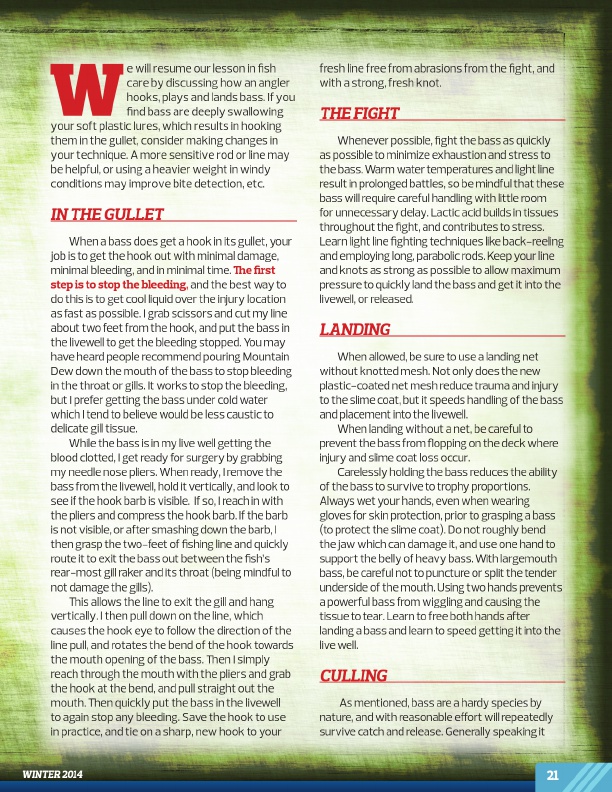
W
e will resume our lesson in fish care by discussing how an angler hooks, plays and lands bass. if you find bass are deeply swallowing your soft plastic lures, which results in hooking them in the gullet, consider making changes in your technique. a more sensitive rod or line may be helpful, or using a heavier weight in windy conditions may improve bite detection, etc.
fresh line free from abrasions from the fight, and with a strong, fresh knot.
thE Fight
Whenever possible, fight the bass as quickly as possible to minimize exhaustion and stress to the bass. Warm water temperatures and light line result in prolonged battles, so be mindful that these bass will require careful handling with little room for unnecessary delay. lactic acid builds in tissues throughout the fight, and contributes to stress. learn light line fighting techniques like back-reeling and employing long, parabolic rods. Keep your line and knots as strong as possible to allow maximum pressure to quickly land the bass and get it into the livewell, or released.
in thE gullEt
When a bass does get a hook in its gullet, your job is to get the hook out with minimal damage, minimal bleeding, and in minimal time. The first step is to stop the bleeding, and the best way to do this is to get cool liquid over the injury location as fast as possible. i grab scissors and cut my line about two feet from the hook, and put the bass in the livewell to get the bleeding stopped. You may have heard people recommend pouring Mountain dew down the mouth of the bass to stop bleeding in the throat or gills. it works to stop the bleeding, but i prefer getting the bass under cold water which i tend to believe would be less caustic to delicate gill tissue. While the bass is in my live well getting the blood clotted, i get ready for surgery by grabbing my needle nose pliers. When ready, i remove the bass from the livewell, hold it vertically, and look to see if the hook barb is visible. if so, i reach in with the pliers and compress the hook barb. if the barb is not visible, or after smashing down the barb, i then grasp the two-feet of fishing line and quickly route it to exit the bass out between the fish’s rear-most gill raker and its throat (being mindful to not damage the gills). This allows the line to exit the gill and hang vertically. i then pull down on the line, which causes the hook eye to follow the direction of the line pull, and rotates the bend of the hook towards the mouth opening of the bass. Then i simply reach through the mouth with the pliers and grab the hook at the bend, and pull straight out the mouth. Then quickly put the bass in the livewell to again stop any bleeding. Save the hook to use in practice, and tie on a sharp, new hook to your
winter 2014
landing
When allowed, be sure to use a landing net without knotted mesh. Not only does the new plastic-coated net mesh reduce trauma and injury to the slime coat, but it speeds handling of the bass and placement into the livewell. When landing without a net, be careful to prevent the bass from flopping on the deck where injury and slime coat loss occur. Carelessly holding the bass reduces the ability of the bass to survive to trophy proportions. always wet your hands, even when wearing gloves for skin protection, prior to grasping a bass (to protect the slime coat). do not roughly bend the jaw which can damage it, and use one hand to support the belly of heavy bass. With largemouth bass, be careful not to puncture or split the tender underside of the mouth. Using two hands prevents a powerful bass from wiggling and causing the tissue to tear. learn to free both hands after landing a bass and learn to speed getting it into the live well.
culling
as mentioned, bass are a hardy species by nature, and with reasonable effort will repeatedly survive catch and release. Generally speaking it
21